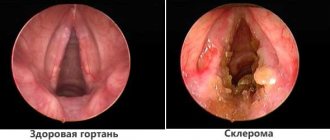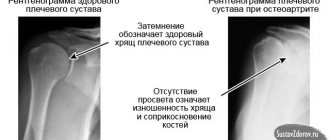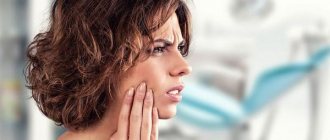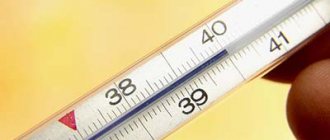Causes of sore throat
Most often, the disease occurs after a bacterial or viral infection gets into the throat.
The pathogen, once on the mucous membrane of the pharynx, begins active activity.
Methods of spreading the disease are airborne and household.
A sick person has pain in swallowing and speaking, has dry mouth and a severe cough. These symptoms indicate the accumulation of toxins produced by pathogenic microflora. Similar signs occur with the development of the following diseases:
- Angina. Inflammation of the tonsils. The throat begins to hurt, and the temperature rises.
- ARVI.
- Laryngitis. Inflammation of the pharynx caused by straining the vocal cords, smoking, air pollution
- Flu. Viral disease with signs of intoxication. Accompanied by weakness and pain in bones and muscles.
- Pharyngitis. Inflammation of the mucous membrane of the pharynx. A dry cough, swelling and inflammation of the lymphoid granules appear. Pharyngitis without fever indicates a decrease in the body's protective functions.
If your throat is swollen and other symptoms of the disease appear, you should seek medical help.
How to relieve pain symptoms
You can get rid of a sore throat when swallowing and difficulty breathing after finding out the cause of the discomfort.
For thyroid disorders, medications are prescribed that affect its function.
As a conservative means to prevent the growth of the cyst, rinsing with Furacilin solution is prescribed, the cyst is irrigated with steroid solutions, and the pharynx is lubricated with Lugol.
For pain caused by a bacterial viral infection, use:
- antibiotic Amoxiclav;
- antiviral Arbidol;
- Loratadine, as a decongestant;
- Inhalipt as a disinfectant;
- Furacilin as an anti-inflammatory agent.
It is necessary to cover your throat with a warm scarf made of natural material, without putting strain on the vocal cords. Dry air is harmful to the mucous membranes of the throat: maintaining humidity at 70-80% will make breathing easier and less painful.
Gargling with Furacilin solution or a soda-saline solution will help temporarily soothe the pain if it is localized in the tonsil area. Sprays are suitable for irrigating the lower parts of the pharynx.
Symptoms
Symptoms of a viral infection:
- dry cough (or with a small amount of sputum);
- temperature increase;
- runny nose;
- throat congestion, sore throat;
- hoarseness of voice.
Symptoms of a bacterial infection:
- enlargement of the submandibular lymph nodes;
- temperature (38°C and above).
Self-medication can only be done in the first days of illness. If there are no signs of improvement, it is recommended to consult a specialist.
First aid for a very sore throat
Gargling is the most effective way to relieve a severe sore throat. For this, special solutions are used that can be quickly prepared at home. When your throat hurts badly, rinsing relieves inflammation and reduces swelling, which allows you to stabilize the condition. But it is important to carry out procedures every 1-2 hours, up to 15 times a day. It is important to use warm solutions for procedures, not hot ones. Otherwise, you can seriously harm the inflamed mucous membrane.
Soda solution for sore throat is considered the simplest and most effective remedy. Baking soda is available in every home, so quickly preparing a rinse solution is not difficult. It is recommended to dissolve a tablespoon of soda in 200 ml of warm boiled water. You can enhance the antiseptic effect by adding salt and iodine to the solution. In this case, add half a spoon of soda and salt and 4 drops of iodine to a glass of water.
A solution with citric acid is effective for rinsing. To prepare, you need to take a teaspoon of citric acid per glass of boiled water. It is recommended to rinse no more than 5 times a day, but it is allowed to alternate them with procedures that use other solutions.
Other effective gargles for when your throat hurts:
- Propolis and sage solution
. First, you should brew the sage herb according to the instructions, and then add a few drops of propolis tincture to it. - Apple cider vinegar solution
. This solution is comparable in its effect to citric acid. It is recommended to take no more than 2 tablespoons of vinegar per glass. Rinsing with this solution should be done no more than twice a day. - Beetroot juice
. To prepare it, raw medium-sized beets are peeled and grated on a fine grater, after which the juice is squeezed out. An equal volume of water is added to it, a teaspoon of table vinegar is added, and rinsing is performed.
To gargle for severe pain, you can also use pharmaceutical products. The most popular and effective are Furacilin
,
Angilex
,
Rotokan
,
Miramistin
, etc. It is also allowed to use herbal pharmaceutical preparations for rinsing.
You can relieve inflammation in the throat at home, and at the same time reduce pain, with the help of warm compresses. These procedures are strictly prohibited when the temperature rises or there is a fever.
The most popular compresses:
- Potato
. This method has been known for a long time. Traditional healers claim that thanks to it you can relieve pain during the day. For the procedure, potatoes are boiled in their skins and then crushed using a potato masher. One tablespoon of table vinegar is added to the mixture. Then the potatoes are placed on a wide bandage and applied to the neck. The compress is wrapped with a warm scarf on top. Keep the compress until the potatoes cool completely. - Mustard
. To prepare it, liquid honey, wheat flour and dry mustard are used in equal quantities. The ingredients are mixed. The resulting mixture, with the consistency of a soft dough, is applied to the throat area, wrapped in polyethylene and wrapped in a scarf. It is recommended to keep this compress for no more than 2 hours.
- Alcoholic
. This is a very effective compress. But it must be applied throughout the night. The procedure consists of folding an ordinary gauze napkin into several layers and moistening it in diluted alcohol or vodka. Then you need to carefully wrap it around your neck and secure it with a plastic bag and then with a scarf.
In the absence of elevated temperature, pain can be relieved using inhalation. Thanks to them, not only pain is reduced, but also in case of bronchopulmonary diseases, sputum discharge is accelerated. It is important that the steam is not too hot. It is recommended to breathe over hot potatoes once a day for 13-15 minutes. Decoctions of medicinal herbs and essential oils can also be used for inhalation. The procedures are carried out using home inhalers twice a day for 5 minutes. It is advisable to take care of your throat after inhalation: you should not drink or talk for several hours.
Diagnostics
The research is carried out by 2 specialists: a therapist and an otolaryngologist. The procedure consists of several stages:
- Anamnesis collection. It is a consultation at which the doctor finds out information about the disease. He listens to the patient’s complaints, finds out the circumstances that preceded the disease and other factors. Based on the data obtained, a clinical picture is drawn up and a treatment plan is prepared.
- Initial examination. At this stage, the condition of the pharyngeal mucosa is studied.
- Instrumental methods. The main diagnostic technique is laryngoscopy. Using a probe and a video camera, the condition of the larynx is examined. If no visible changes are detected in the nasopharynx, the doctor is obliged to exclude pathologies of the larynx (from laryngitis to malignant tumors). If it is difficult to breathe, but the upper respiratory tract is normal, you should consult a neurologist or orthopedist. In addition, MRI diagnostics and radiography of the thoracic and cervical spine are performed.
- Laboratory methods. This includes nasal and throat swabs and a blood test. Smears allow you to study the composition of the microflora and identify the causative agents of the disease. A blood test most often indicates the presence of inflammation.
Acute sore throat can be a symptom of various diseases; diagnostics allows you to make the most accurate diagnosis.
How to treat a throat if it hurts to swallow
For different etiologies of the disease, certain medications are suitable. For example, for a runny nose or inflammation of the larynx, anti-inflammatory medications are well suited; in difficult cases, after complications, antibiotics may be prescribed. Mild forms of illness can be treated with traditional recipes. A sore throat is a symptom of an underlying disease, so treatment methods will depend on the underlying cause, which must be determined by the doctor. The treatment regimen is prescribed individually.
How to treat a sore throat in this case depends on the nature of the disease. First, you can use antibiotic-free lozenges, lozenges containing phenol, for example, Strepsils, Grammidin, Hexoral. These medications contain essential oils, have an analgesic effect in the throat area, and have a healing effect against inflammatory processes in the pharynx mucosa.
Inhalers, sprays Kameton, Hexoral Spray, Ingalipt. These effective drugs have an analgesic, antiseptic effect, relieve acute attacks of pain, soothe dry cough, and facilitate swallowing. During use, it is necessary to direct the inhaler tube as accurately as possible to the inflamed area and press the valve twice. The inhaler should be used 6-7 times a day.
Rinsing can be done using home remedies (herbs, honey, salt and soda) or using ready-made solutions, for example, Aqualor throat, Lugol solution with glycerin, Laripront. These products have mucolytic, antimicrobial properties; gargling helps reduce pain, red throat, and other symptoms of the acute phase of the pathology.
No temperature
In some pathologies, swallowing becomes painful, but the body temperature does not increase. Taking pills and other medications are prescribed depending on the pathology that caused this symptom:
- When treated with medications, antiviral agents are prescribed, for example, Anaferon, Arpetol, Groprinosin. In case of complications or a complex course of the disease, antibacterial drugs may be needed: Clindamycin, Azithromycin, Ceftriaxone. The use of these medications must be agreed upon with the attending physician.
- Candidal pharyngitis, which is accompanied by fever, is rarely treated with antifungal agents, for example, Fucis, Mikosist, Fluconazole, Nystatin.
- Be sure to gargle if it hurts to swallow. This procedure will stop the spread of infection and relieve local symptoms. Use Chlorophyllipt, Iodinol, Chlorhexidine, chamomile infusion, water-salt solution, and a weak solution of potassium permanganate for rinsing.
Such symptoms are inherent in all infectious and viral diseases that cause inflammation of the throat and irritation of the mucous membrane. Therapy for such pathologies coincides with the methods described above, which include:
- anti-inflammatory drugs;
- antiseptic medications;
- sprays, inhalers;
- solutions, decoctions for rinsing.
As mentioned above, a sore throat can be caused not only by a harmless cold or hypothermia, this symptom may indicate the occurrence of a serious pathological process in various organs and systems.
Using the following examples, we will consider which medications can be used to eliminate sore throat by acting directly on the cause of the disease:
- Diaphragmatic hernia. The burning sensation in the esophagus will be reduced by: Almagel, Omeprazole, Ranitidine; to reduce spastic pain: Drotaverine, No-shpa.
- Reflux esophagitis. To suppress the secretion of gastric acid, Omeprazole, Lansoprazole, Pantorazole, Rabeprazole, Esomeprazole are prescribed. To neutralize hydrochloric acid, antacids are prescribed: Phosphalugel, Maalox, Almagel, Topalcan, Gaviscon. To stimulate gastrointestinal motility, prokinetics are prescribed, for example, Motilium.
- Esophageal stenosis. To reduce the acidity of gastric juice: Famotidine, to stimulate the regenerative processes of the esophageal mucosa: Dalargin, Ventramin; against heartburn: Almagel, Maalox, etc.; To form a protective film on the mucous membrane from irritating factors, astringent enveloping agents are prescribed: infusion or decoction of blueberries, bird cherry, sage, etc. If esophageal cancer is diagnosed, chemotherapy is prescribed.
- Catarrh of the esophagus. The main features of the structure of the esophageal mucosa in catarrh: swelling, hyperemia, looseness. To normalize the functioning of the esophagus, antacids are prescribed, as well as drugs from the famotidine group (for example, Kvamatel).
Self-medication is prohibited; drugs for the treatment of the esophagus must be prescribed by a doctor after a comprehensive examination of the patient (which should include radiography of the esophagus, laboratory tests, etc.).
What to take for a sore throat? To eliminate the symptom of sore throat itself, the following universal methods are used:
- rinsing;
- inhalation;
- sprays and dissolving lozenges.
Rinse
For rinsing, it is recommended to use solutions with an analgesic effect, for example OKI, a non-steroidal anti-inflammatory drug. The active ingredient ketoprofen effectively relieves pain and inflammation and does not affect bacteria or viruses. Regular use helps reduce swelling, redness, and pain.
The drug Chlorhexidine has also gained wide popularity. Rinsing with this medicine provides antiseptic, antibacterial and analgesic effects. The solution prevents the proliferation of pathogens, so it can be used not only to relieve pain symptoms, but also to treat infectious diseases of the throat. For severe pain in the throat, it is recommended to gargle 3-4 times per day with 1 tbsp. solution without dilution in water.
Inhalations
Inhalations are also widely used to treat sore throat, using various solutions: analgesic (Lidocaine solution), antibacterial (Bioparox, Gentamicin), antiseptic (Furacilin, Miramistin), anti-inflammatory (Chlorophyllipt, Rotocaine), immunomodulating and antiviral (interferon, Derinat).
Aerosols and sprays are one of the most convenient and effective methods for relieving a sore throat. They can also be antibacterial (Anginal, Bioparox), anti-inflammatory and analgesic (Tantum Verde), combined (Strepsils Plus, Miramistin, Hexoral). No less convenient for eliminating a sore throat are lozenges containing medicinal substances (Strepsils, Doctor Mom, Koldakt Lorpils, Carmolis, etc.).
A sore throat should be the reason to contact your local physician. If necessary, the specialist will refer the patient to an otolaryngologist or dentist, depending on the symptoms. If you have a sore throat during a cold or flu, the patient needs to gargle. Garlic will have a therapeutic effect when added to boiling water, as will beets with apple cider vinegar. You can make chicken broth to soothe your throat.
Systemic treatment of sore throat
Medicines prescribed by specialists fight the cause of the disease and eliminate existing symptoms that cause discomfort to the patient.
Tablets and lozenges
Systemic treatment includes taking antihistamines, anti-inflammatory and antipyretic drugs. The following tablets and lozenges are prescribed:
- Trachisan;
- Falimint;
- Agisept;
- Decathylene;
- Sebidin;
- Suprima-lor.
For cutting pain in the throat, these drugs should be taken 2-4 times a day for a week. Before use, it is recommended to familiarize yourself with contraindications and dosage.
Throat sprays
A cutting sore throat is treated with combination sprays:
- Hexidine. Kills germs and has an antiseptic effect. They are used not only for respiratory diseases, but also for dental problems. A child is prescribed an aqueous solution, an adult an alcohol solution (from 12 years of age). The maximum duration is 7 days.
- Ambassador Contains plant components, such as propolis. Effective in the treatment of bacterial and viral infections, promotes healing of the mucous membrane. The product has analgesic properties and relieves inflammation. Used to treat ulcerative and aphthous stomatitis. Course of application – 1 week. Allowed for use from the first year of life. The product is suitable for pregnant and lactating women.
- Maxicold. Local antiseptic, used to combat fungal diseases. It is recommended to hold your breath while spraying. The product envelops damaged tissue and reduces pain. Can be used from 3 years of age.
- Cameton. An affordable remedy that suppresses the proliferation of pathogens and improves the breathing process. Can be used from 5 years of age, it is not recommended to use for longer than 2 weeks.
- Derinat. Bacteriostatic, immunomodulatory and antiseptic. It is used as a prophylactic for chronic tonsillitis, as well as after hypothermia.
- Inhalipt. An antimicrobial drug with anti-inflammatory and cooling effects. Contraindications – age under 3 years, hypersensitivity, allergy to certain components.
For mild cases of the disease, sprays are used as the main therapy, for severe cases - as an additional remedy.
Physiotherapy
These procedures represent the impact of a physical factor (current, magnetic field, infrared and ultraviolet rays, temperature) on the source of the disease. Treatment is prescribed a few days after the onset of the disease. Basic techniques:
- Inhalation. This method allows you to treat a sore throat even at home. Under the influence of warm, moist steam, blood circulation increases and swelling decreases. Can be used in conjunction with anti-inflammatory drugs.
- Electrophoresis. Prescribed in the presence of concomitant diseases and intoxication of the body.
- Phonophoresis. It is used for chronic tonsillitis using aloe extract and extracts from medicinal mud. The method is effective for treating adhesions on the tonsils.
- Ultraviolet irradiation. Divided into local and general. In the first case, a tube is inserted into the oral cavity; in the second, the collar area is treated.
- Ultrasound therapy. The effect of ultrasonic vibrations on the tonsils, activating local immunity. It is prescribed for adults, because this procedure is too painful for children.
- Laser therapy. A modern painless method with a quick effect. Exposure to rays reduces pain and swelling. A laser is used to remove tonsils without blood loss or risk of infection.
- Mud therapy. Used for resolving adhesions. The mud is applied to the front of the neck and collar area. The procedure is actively used in medical sanatoriums.
- Ultrafrequency therapy. Used to activate leukocytes, relieve inflammation and swelling in the tonsils. Complex treatment combined with ultrasound is most effective.
These treatment methods are aimed at activating various chemical and biological processes that have a beneficial effect on the course of the disease.
UHF therapy
With this method, treatment occurs under the influence of a high-frequency electric field. The device has an anti-inflammatory and analgesic effect. Damaged tissues begin to regenerate intensively.
The rays penetrate the entire depth of the body, creating a protective barrier. This slows down the absorption of toxins into the blood. Therapy is indicated for purulent inflammation, if conditions are created for the outflow of fluid.
This method is contraindicated in the following cases:
- angina;
- pregnancy;
- bleeding;
- oncological diseases;
- presence of a pacemaker.
Used to treat dental diseases.
Pain in the side of the throat
Despite the variety of causes of unilateral pain in the throat, most often this symptom is caused by pharyngitis.
Sharp pain can occur suddenly with common respiratory diseases. The mucous membrane of the throat becomes inflamed when the body is infected by viruses or bacteria, increasing pain in those areas where additional irritation occurs with mucus constantly flowing down the walls of the pharynx. Therefore, if the pain is caused by pharyngitis, then it is the back wall of the nasopharynx that will be affected to a greater extent. An inflammatory process that causes pain in the back of the pharynx often occurs with a retropharyngeal abscess. This disease causes complications after improper treatment of nasopharyngeal diseases, such as scarlet fever, influenza, measles, and is characterized by the occurrence and development of purulent processes in the lymph nodes. However, this diagnosis is rarely made. Most often, the disease affects children and people with weakened immune systems.
The main symptoms of a retropharyngeal abscess:
- pain in the back of the throat;
- difficulty swallowing;
- when swallowed, food often enters the nasal passages;
- nasal congestion;
- a sharp increase in temperature;
- unnatural position of the head (tilt up or to the side).
The cause of a purulent abscess is bacteria, so treatment of a sore throat in this case should be based on the use of antibiotics.
Often in patients with removed tonsils, inflammation of the accumulations of lymphoid tissue located in the lateral parts of the pharynx occurs. Moreover, such an inflammatory process affects the follicles and so-called ridges on only one side, causing pain on the right or left. This disease is called hypertrophic lateral pharyngitis.
Pathogenic microorganisms do not always cause unilateral localization of sore throat. Pain that feels like a cutting sensation in the throat can also result from a foreign object entering the throat. For example, the cause is an accidentally swallowed bone. In this case, the victim should be immediately hospitalized to provide emergency qualified assistance.
A sore throat can also be the reason that the inflammatory process in the throat will be located only on the right or left.
After all, inflammation of the tonsils caused by a bacterial infection most often affects only one side. Bilateral inflammation is much less common.
Another cause of sore throat on only one side may be paratonsillitis, an inflammatory process that occurs as a result of complications of tonsillitis. The disease is localized in the part of the larynx where the source of the initial infection was located. Treatment involves the use of antibiotics in conjunction with detoxification, antiallergic and antipyretic drugs.
Treating a throat at home
Treatment with folk remedies can be used in combination with the main therapy or independently in the early stages of the disease. If you have a sore throat for a week and nothing helps, you should stop self-medicating and seek medical help.
Rinsing
Rinse principles:
- the solution should be warm (+35...+37°C);
- decoctions are prepared for the day, solutions are used immediately after preparation;
- the frequency of procedures is from 3 to 6 times a day.
Alternation of means is allowed, and the break between them should be at least half an hour.
Pharmacy solutions for rinsing
Chlorhexidine is used from pharmaceutical drugs. This product destroys bacteria at the cellular level. The finished solution has a concentration of 0.05. It is recommended to dilute the more saturated preparation with water. Frequency of use – 4 times a day (for a week).
Rotokan is an alcohol infusion of medicinal herbs (yarrow, calendula and chamomile).
The product is safe and effective and is used to treat tonsillitis and pharyngitis. Directions for use: add 250 ml of water to 1 teaspoon of product and stir for 30 seconds.
Recipes for rinsing solutions
Rinse products are prepared from one or more types of herbs. Cooking methods:
- Pour a glass of boiling water over calendula and plantain (10 g each). Let it brew for 20 minutes. Gargle every 3 hours.
- Chamomile flowers and linden inflorescences (2:1) pour 250 ml of boiling water. After 30 minutes the solution can be used.
- St. John's wort and calendula (in equal parts) are brewed with hot water.
- Pour boiling water over violet flowers (20 g), violet grass (10 g) and tricolor leaves (30 g). Leave for 2 hours, strain and gargle.
All recipes use plants that have anti-inflammatory and bactericidal properties.
Honey for sore throat
If you have a terrible sore throat, the most effective treatment is linden honey (or other dark varieties of this product). The drug is taken 3 to 6 times a day on an empty stomach. Cooking recipes:
- Slow absorption of honey in the mouth. By enveloping the mucous membranes, honey will prevent the proliferation of bacteria. For greater efficiency, you can mix the beekeeping product with butter (1:1).
- Diluting honey (1 tsp) in warm water (1 glass). Gargle every half hour.
- Adding honey to tea or milk (drinks are preheated to +50°C). Higher temperatures kill the beneficial properties of the product.
- Adding honey and lemon juice to tea or milk.
There are many recipes with different additives. For example, you can add aloe juice or cinnamon to the drink.
Drinking regime
The amount of warm liquid consumed during illness should be at least 2 liters.
It is especially important to maintain a drinking regime when the temperature rises.
Treatment
What to do if your throat hurts and your body temperature is elevated. The type of treatment directly depends on the type of causative agent of the infectious disease. During the examination, the doctor determines the pathology based on clinical signs.
What to treat if your throat hurts at a temperature of 38 degrees. Therapy for influenza and acute respiratory viral infections consists of drinking plenty of fluids, especially mineral waters.
The temperature cannot be lowered below this value. Give your immune system a chance to fight viruses. For hyperthermia above this level, give the antipyretic drug Paracetamol, Ibuprofen.
If your throat hurts at a high temperature, do not try to establish a diagnosis and apply alcohol compresses to the neck - this will cause the infection to spread. It’s better to call an ambulance or see an otolaryngologist.
Follicular or lacunar tonsillitis requires the use of prescription oral antibiotics. Only an ENT doctor can select these drugs correctly. Medicines have many contraindications.
Prevention
Procedures that allow you to get sick less often:
- Increasing immunity (hardening).
- Regular intake of vitamins and minerals.
- Maintaining normal humidity in the apartment and work area.
- Quitting alcohol and smoking.
- Regularly change your toothbrush (at least once every 3 months). Pathogenic microorganisms remain on the bristles.
- In the cold season, it is recommended to gargle with sea water or soda solution.
- Regular ventilation of the living space.
- It is recommended to drink tea with honey and lemon once a day.
- Timely wet cleaning of the premises.
During periods of exacerbation of infectious diseases, it is recommended to avoid places with large crowds of people.
Steam inhalations
Inhalations reduce inflammation and swelling of the mucous membranes, eliminate sore throat, ease breathing, and increase local immunity.
Most often, boiled hot potatoes or hot infusions of herbs (chamomile, calendula, eucalyptus) are used. One of these remedies is placed in a pan, over which a person with a sore throat must bend and inhale the vapors emanating from it. Cover yourself with a large towel or blanket. The distance between the face and the pan should be 20–25 centimeters.
Inhalation duration is 7–10 minutes. The procedure is not performed at elevated body temperatures.
Sore throat and temperature 38: treatment of pain in an adult
A sore throat with a temperature of 38-39 degrees indicates the occurrence of infectious diseases such as influenza, pharyngitis, laryngitis, sore throat, etc.
If the treatment of these diseases is not timely, this may affect the functioning of the gastrointestinal tract, kidneys, and heart.
When the throat is red, the discomfort can be increasing, subsiding, or constant. If this condition lasts for a year and does not stop after treatment with all kinds of medications, then most likely the disease has become chronic.
At the same time, a sore throat in an adult with a temperature of 39 degrees can occur at any time, but often this phenomenon occurs in the evening and at night.
In addition, according to localization, the pain can be one-sided or cover the entire throat. Unpleasant sensations gathering in one side often indicate the presence of an abscess, injury or sore throat.
Bilateral discomfort indicates the presence of systemic pathologies:
- oncohematological;
- renal;
- endocrine.
And pain localized in the lower region of the throat signals that there is an inflammatory process in the epiglottis.
Also, discomfort in the throat is a frequent companion to many diseases of the respiratory tract. Moreover, if you treat such a condition using inhalations, rinses and aerosols, this will only eliminate the symptom, but will not get rid of the disease itself.
Lack of treatment for serious diseases such as pharyngitis, sore throat or damage to the pharynx can contribute to the development of complications.
Therefore, if you have a sore throat, with a temperature of 38-39 degrees, you need to make an appointment with an ENT specialist.
Causes
A red throat and high fever may occur due to the following factors:
- allergy;
- viral infection (herpes, mononucleosis, influenza);
- dry air;
- staphylococcal and streptococcal infection;
- hypothermia;
- prolonged and strong increase in voice;
- irritation of the mucous membranes with alcohol, chemicals, tobacco smoke;
- lack of sleep, chronic fatigue;
- throat injury.
- long-term treatment with immunomodulators, antibiotics, chemotherapy.
Diseases characterized by a red throat are:
- Sore throat, inflammation of the larynx and pharynx, sinusitis, adenoiditis.
- Iron-deficiency anemia.
- Ulcer or stenosis of the esophagus, reflux esophagitis, gingivitis.
- Venereal diseases.
- Tuberculosis.
- Abscess or dental caries.
- Osteochondrosis of the cervical vertebrae.
- Tumor-like formations.
- Stomatitis, blisters and ulcers in the mouth.
Signs accompanying sore throat
A red throat often becomes sore, causing coughing, soreness and sneezing.
The patient often complains of foreign body sensations and dry throat. The cervical lymph nodes also enlarge, chest discomfort occurs, and the voice becomes hoarse and muffled. There is also a feeling that someone is pressing on the neck. As a rule, infectious diseases are accompanied by symptoms of intoxication, high temperature (38-39) and chills.
With a viral infection, pain in the throat is accompanied by an unproductive cough, hoarse voice, rhinitis and fever. If the body is infected by bacteria, fever and lymphadenitis appear. In the absence of proper therapy, complications such as glomerulonephritis, rheumatic carditis or tonsillitis develop.
In some cases, the throat hurts constantly and occurs without fever. This phenomenon often occurs when foreign objects, such as leftover food, enter the throat. When they become sharp in the throat, suffocation develops.
In addition, with stomatitis, painful sensations in the larynx cause ulcers. And people suffering from chronic pharyngitis, reflux esophagitis, tumors also experience discomfort in the throat without fever.
In acute inflammation of the tonsils and pharynx, the pain may radiate to the ear. In this case, it becomes more intense in the evening, and this condition is accompanied by intoxication. At the same time, tinnitus appears, as a result of which the patient begins to hear poorly, and sometimes suppuration is noted.
With diphtheria, scarlet fever, measles and chickenpox, the ears and throat hurt and become inflamed. If an acute inflammatory process occurs in the pharynx, then in addition to damage to the posterior wall, the nearby lymphoid tissue becomes inflamed. The patient also develops minor pain and sore throat, but his general condition is normal.
Scarlet fever is an infectious pathology that occurs as a result of a streptococcal infection entering the body. This disease is characterized by the following symptoms:
- red throat;
- pain;
- redness and rashes on the skin;
- the tongue becomes bright red.
Moreover, discomfort in the throat can occur with diphtheria. This disease causes fever, swelling and damage to the respiratory system. Treatment of this pathology is carried out only in a hospital setting.
With tonsillitis, severe pain in the throat occurs suddenly, while lymphadenitis develops, muscles and head ache. This condition is often accompanied by elevated temperature (39 degrees). There may also be a lack of appetite, and the tonsils become large and covered with a white coating.
Throbbing pain localized to one side is characteristic of a peritonsillar abscess. At the same time, the patient’s temperature rises to 39-40 degrees, which is complemented by a feeling of weakness and weakness.
In addition, discomfort in the throat is a common sign of allergies, which is complemented by such manifestations as:
- runny nose;
- swelling of the face;
- lacrimation;
- redness of the skin.
In the presence of reflux esophagitis, gastric juice is thrown into the upper parts of the esophagus.
As a result, the pharyngeal mucosa becomes irritated and a sore throat occurs. During physical activity, the patient has difficulty breathing and feels as if there is a lump in the throat. All this is also accompanied by belching and heartburn.
If there is a tumor in the throat, then the patient experiences constant pressing and dull painful sensations.
When the formation grows into nearby tissues, the pain becomes unbearable, so it can only be eliminated by taking narcotic painkillers.
Diagnostics
In order for a red throat to stop hurting, it is necessary to identify what causes this condition. For this purpose, the ENT interviewes the patient, listens to his respiratory tract and performs pharyngoscopy.
In this case, a smear is often taken from the throat to study the microflora and determine the sensitivity of bacteria to a particular group of antibiotics. Additional diagnostic methods include measuring the concentration of hydrochloric acid in the esophagus, X-rays of the neck and chest.
Treatment
First of all, the patient should not overstrain the inflamed ligaments. So, he needs to talk less, not smoke and drink plenty of fluids, which will soften his throat. In addition to antiseptic rinses, you can dissolve lozenges that have an antibacterial effect and take antitussive lozenges.
Symptoms that require immediate attention to an ENT specialist include:
- labored breathing;
- red throat, accompanied by severe pain;
- dizziness;
- high temperature (39-40 degrees);
- vomit;
- cough;
- nausea;
- abdominal discomfort.
Diet therapy
The diet for sore throat, pharyngitis and other throat diseases should be gentle. So, during the illness you should avoid salty, sour, pepper and hot foods. Priority should be dairy products - yoghurt, kefir, porridge.
In addition, do not forget about warm drinks, thanks to which you can remove intoxication, prevent dehydration and remove toxins from the body. Therefore, it is useful to supplement drug treatment with the use of fruit drinks, warm mineral water, tea, compotes and infusions.
Warm drinks help stimulate blood circulation in the throat, they soften it, relieving soreness and dryness. It is better to avoid alcoholic, carbonated, hot or cold drinks.
Treatment with drugs
A red, sore throat should be treated by gargling with disinfectant solutions such as Furacilin, Chlorophyllipt and Chlorhexidine. In addition, solutions of iodine, soda and salt can be used every 2 hours. And to soften the mucous membrane, it is recommended to rinse with a solution of hydrogen peroxide (3%), which also has a bactericidal effect.
In addition, comprehensive treatment of a sore throat is carried out. For this purpose, anti-inflammatory and antimicrobial sprays are used - Hexoral, Cameton, Yox.
To get rid of a sore throat or pharyngitis, the doctor prescribes sprays such as Bioparox, Tantum Verde or Miramistin. However, before treating a red throat with such means, you need to make sure that their components do not cause an allergic reaction.
In addition, patients need to dissolve lozenges and lozenges - Falimint, Septolete and Strepsils. Corticosteroids and antihistamines (Zodak, Zyrtec) can also be prescribed, which help relieve inflammation, pain, redness and swelling.
For infectious sore throat, antibiotics may be prescribed. As a rule, penicillins and cephalosporins are used:
- Cefotaxime;
- Amoxiclav;
- Suprax.
If the pain is very severe, then Ketanol or Nurofen is prescribed. And to activate the body’s defenses, Imod is prescribed, which is taken four times a day for 10 days.
Physiotherapy
A red throat can be treated with physiotherapy. Thus, aerosol therapy is a gentle and effective method that has a strong analgesic effect.
Inhalations with the addition of essential extracts, herbal infusions and ultrasonic inhalations with saline or mineral water effectively eliminate unproductive cough, soften the mucous membrane and facilitate the functioning of the respiratory organs.
In addition, a sore throat can be treated with vibroacoustic effects and magnetotherapy. These procedures normalize microcirculation and improve innervation and trophism.
Moreover, with their help you can remove congestion and activate the influx of leukocytes that localize pathogenic microflora. This treatment helps strengthen the immune system, relieve pain and eliminate the inflammatory process.
In addition, it is useful to use a laser on inflamed tonsils and the back wall of the pharynx. This procedure is very effective, using a special tip through which the laser beam affects the problem area. It is worth noting that the impact can be internal or external.
stopgripp.ru











